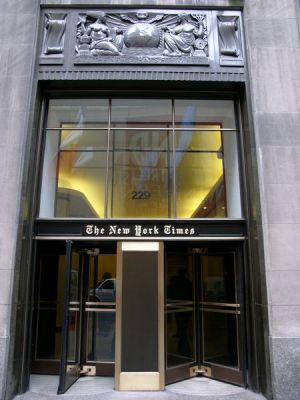 The Times welcomes comments and suggestions, or complaints about errors that warrant correction. Messages on news coverage can be e-mailed to nytnews@nytimes.com or left toll-free at 1-888-NYT-NEWS (1-888-698-6397). Comments on editorials may be e-mailed to letters@nytimes.com or faxed to (212) 556-3622.
It has been a long, but interesting, trip into the digital-era machinery of the New York Times correction process and, to be perfectly frank about it, the gears all clicked into place in this case.
The Times welcomes comments and suggestions, or complaints about errors that warrant correction. Messages on news coverage can be e-mailed to nytnews@nytimes.com or left toll-free at 1-888-NYT-NEWS (1-888-698-6397). Comments on editorials may be e-mailed to letters@nytimes.com or faxed to (212) 556-3622.
It has been a long, but interesting, trip into the digital-era machinery of the New York Times correction process and, to be perfectly frank about it, the gears all clicked into place in this case.
Yes, I sent quite a few emails to various addresses at the Times. Yes, I went into several voicemail machines. But a representative of the newspaper's national desk did call me and we discussed the error, from that long-ago story about the election of a new Episcopal bishop out in California. That article said:
The Episcopal Church is a small but rich and powerful member of the Anglican Communion, which has 77 million members, the second-largest church body in the world, and is presided over by the archbishop of Canterbury.
If you want to follow the whole trail of my posts about this issue, please go here, here and finally here. The national desk asked if I had any information to offer in support of my request for a correction and I sent several URLs about the size of the Eastern Orthodox Communion and the Anglican Communion. It was easy to find Anglican statistics. The key, as several comments have noted here at GetReligion, was trying to establish an estimate, repeat estimate, of the size of the combined churches within Orthodoxy.
So here is what we ended up with, as published today in the Times:
An article on May 5 about the election of a new bishop in the California diocese of the Episcopal Church referred incorrectly to the worldwide Anglican Communion, to which the church belongs. It is the third largest church body in the world, not the second. (The error also occurred in three previous articles going back to 1989.)
Why go through all of this? Well, when newspapers make the same errors over and over it often encourages readers to see bias where there may be no bias. And the Times is not a normal newspaper, but the establishment's newspaper of record. Note the reference that this particular error "also occurred in three previous articles going back to 1989."
This is one reason that old-fashioned journalistic concepts like accuracy, balance and fairness remain important.
Or, as the late A.M. Rosenthal liked to put it, newspapers are supposed to "keep the news straight." So I was interested -- but not surprised -- to learn it was that angry, high-strung old journalist who helped modernize and standardize the newsroom process that led to clear, prominent corrections. Reporter Craig Silverman at Editor & Publisher wrote the story:
The Associated Press noted [that] Rosenthal "... began the paper's practice, now imitated by many others, of running corrections as a prominent daily fixture." The Los Angeles Times wrote, "When the newspaper erred, he insisted that it admit its mistakes in a daily Corrections column, which he introduced in 1972. He later added the Editor's Note, which addressed flaws such as errors of omission and lapses in taste and standards."
As former New York Times Assistant Managing Editor Allan M. Siegal wrote in the introduction to the 2002 collection of amusing Times corrections, "Kill Duck Before Serving," Rosenthal told his department leaders in 1970 that "corrections or denials or amplifications don't really catch up with the original because they are not given proper display."
Rosenthal demanded change on his own ship and, after a few years, his memo on the subject reached the captains of other news vessels.
Two years after Rosenthal's missive, the paper anchored its corrections in one place inside the paper. Now, the logic went, people knew where to find them every day. The industry cheered, and many papers fell into line. Today, almost 35 years after Rosenthal created the modern correction, you can pick up nearly any North American city daily, open it to page two, and spot one or more corrections tucked away in the bottom corner.
I urge you to check out Silverman's piece. It's a fitting variation on the common themes in many of this week's stories and tributes to Rosenthal, including this touching new piece by his son, Andrew Rosenthal, and my own column for Scripps Howard.
